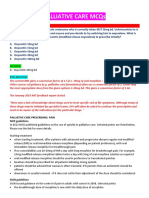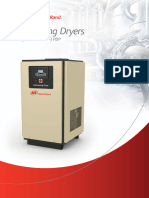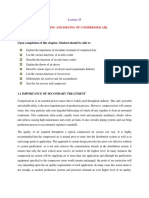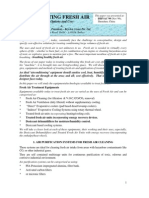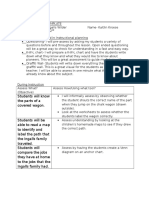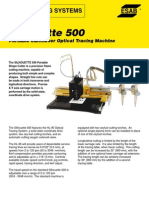1105 e Hybrid-Dryer
1105 e Hybrid-Dryer
Uploaded by
Joost PostCopyright:
Available Formats
1105 e Hybrid-Dryer
1105 e Hybrid-Dryer
Uploaded by
Joost PostOriginal Title
Copyright
Available Formats
Share this document
Did you find this document useful?
Is this content inappropriate?
Copyright:
Available Formats
1105 e Hybrid-Dryer
1105 e Hybrid-Dryer
Uploaded by
Joost PostCopyright:
Available Formats
Hybrid Dryer
1105a-09.11
Filter- und Trocknertechnik GmbH
Mühlenstraße 21, D-24855 Bollingstedt Tel.: +49-(0)4625-189042 Fax: +49-(0)4625-189048
Internet: www.fut-gmbh.de ▪ e-mail: info@fut-gmbh.de
Hybrid Dryer
Synergy results in economic
Compressed air for The principle of the desiccant dryer
Desiccant dryers are being
highest requirements used, when the com-
pressed air system is
exposed to temperatures
Certain production processes such as instrument air, air for pneu-
below the freezing point or
matic control systems and process engineering solutions, feed air
when a particularly low
for the transport of powdery materials in the chemical, pharma-
dew point is required for a
ceutical and food processing industries etc. require dependably
specific applications.
treated, high-quality compressed air – technically oil-free and
very dry – with pressure dew points of under 0°C down to -40°C. The air is channeled
through a vessel filled with
If the compressed air is channeled through extensive pipe net-
an adsorption media (activated Alumina), where the water vapor
works or in areas exposed to ambient weather conditions, distur-
is being captured at the surface of the adsorbent.
bances due to frozen condensate are – especially in winter time
– the order of the day. These drying agents can be regenerated and used again and
again. The dryers have two desiccant vessels.
Until now the economical treatment of a dew point under 0°C
was only achievable by using desiccant dryers. For capacities The compressed air supply is being controlled, so that only one
over 1000m3/h mostly heated regenerative desiccant dryers vessel dries, whereas the other vessel is being regenerated.
(blower purge dryers) were used, which, in comparison to heat- Heated regenerative desiccant dryers (blower purge dryers) are
less regenerative desiccant dryers, are more cost-effective. being regenerated using a blower and mostly an electric operat-
ed heater.
compressed air inlet compressed air outlet
regeneration
Ways to compressed
air inlet
fan heater dustfilter
air/air heat
exchanger
air treatment
dessicant adsobers
(A)
Air-to-air (B) Air-to- (E) Optional fine oil
heat exchanger
air/refdrigerant
heat Refrigerant heat filter
exchanger exchanger
bypass
(C)
separator/filter
regeneration
air outlet
water separator condensate drain
and oil finefilter
(D) Automatic
condensate drain
The HybriDryer unites all advantages
The DELTECH Hybridryer is a combination of a refrigeration
dryer and a heated regenerative desiccant dryer. The saturated
compressed air first enters the refrigeration dryer, it is cooled
The principle of the refrigerated down to +3°C and the water vapor is condensed. The conden-
compressed air dryer sate is then separated from the compressed air flow in the sepa-
rator filter.
They are used in areas, where the compressed air network is
After that the air leaves the refrigeration dryer circulation. The
exposed only to temperatures above the freezing point.
absolute temperature and the dew point are still at +3°C and the
Warm, saturated compressed air is firstly being cooled down via relative humidity is 100%! - the ideal condition of the adsorbent
an Air-to-Air heatexchanger (A) and than further cooled down in is achieved!
an Air-to Refrigerant heatexchanger (B), which is being con-
The compressed air is then introduced into the desiccant dryer,
trolled by a expansion valve. The water vapor condenses into liq-
where it is dried to dew points of -25°C to - 40°C.
uid and is than separated from the compressed air stream in the
cyclone/demister separator/filter (C) and discharged by the fully The still cold compressed air is then supplied to the integrated
automatic condensate drain (D). air-to-air heat exchanger and thus cools the inflowing com-
pressed air.
The cool, dry air is now being used to cool the warm incoming
compressed air by means of the Air-to-Air heat exchanger (A). An ambient air temperature controlled bypass in the combination
makes it possible to bypass the desiccant dryer during the sum-
mer period and only use it in the winter time, as required. Thus
the slightly higher investment costs justify themselves even more
clearly by the considerably lower operating expenses.
Filter- und Trocknertechnik GmbH
Mühlenstraße 21, D-24855 Bollingstedt Tel.: +49-(0)4625-189042 Fax: +49-(0)4625-189048
Internet: www.fut-gmbh.de ▪ e-mail: info@fut-gmbh.de
Hybrid Dryer
cal advantage: the DELTECH HybriDryer Series
All the advantages of the HybriDryer at a glance
Flexible
Environmentally
friendly
Economical
䡲 Low operating expenses in com-
parison with heated regenerative
desiccant dryers
䡲 Selectable summer/winter
operation (+3°C / -25°C / -
40°C)
䡲 Constant pressure dew point
䡲 No temperature or dew point
peaks during switch over
䡲 No loss of compressed air
䡲 Efficient finest oil filtration at the
coolest point
䡲 Extended lifetime of the
absorbent through extremely low
regeneration temperatures
䡲 Optimal outlet temperatures
䡲 Volume flows of 1200
to 9000 m3/h
(higher capacities upon request)
䡲 Lowest operating expenses
energy consumption W/m3
40 20
adsorption = g H2O / 100g adsorbent
silicia gel
hea m
t em
les br
15 s re
gen
an
ed
= e rye
he rativ r
a te *
30 dr
eg e
ed
esic
activated ner can
alumina 10 a tive
t dr
yer
des
ic c an t
molecular sieve dryer
20 5
H yb refrigera
ridry tion drye
er
r
10 dew 1 2 3 4 5 6
point (-70 ∞C) (-40 ∞C) (-20 ∞C) (+3 ∞C) (+7 ∞C) (+10 ∞C)
class HybriDryer
regenerative desiccant dryer refrigeration dryer
0 20 40 60 50 100 membrane dryer*
* only for small volume flows
relative huminity %
ideal condition for the adsorbent activated alumina dew point classes and their energy requirements
200 t
desiccant dryer* C02 reduction r*
ye
49% t dr
an
CO2 emissions in 12 months
c
sic
dew point -40∞C de
100 t
savings
investment
HybriDryer
dew point -40∞C HybriDryer
1 2 3 4 5
– flow 5000 m3/h in 12 months *market
standard years *market standard
CO2 reductions with the HybriDryer cost savings with the HybriDryer
Filter- und Trocknertechnik GmbH
Mühlenstraße 21, D-24855 Bollingstedt Tel.: +49-(0)4625-189042 Fax: +49-(0)4625-189048
Internet: www.fut-gmbh.de ▪ e-mail: info@fut-gmbh.de
Hybrid Dryer
The desiccant dryer section displaying the bypass for The refrigeration dryer section of
“summer/winter” operation the HybriDryer with the refrigera-
tion specifics
Technical Data
operation +3°C operation -40°C
DHD 400 1200 4300 2250 1550 3,1 5,7
DHD 500 1500 4300 2250 1550 4,3 7,5
DHD 670 2000 4600 2250 1900 6,7 10,8
DHD 835 2500 4600 2250 1900 7,5 12,4
DHD 1000 3000 4600 2250 1900 9,4 15,7
DHD 1335 4000 4600 2250 1900 11,5 19,4
DHD 1670 5000 5150 2600 3250 11,5 21,2
DHD 2000 6000 5150 2600 3200 13,8 25,4
DHD 2335 7000 5500 2600 3600 15,3 28,6
DHD 2670 8000 5500 2600 3600 17,7 32,7
DHD 3000 9000 5550 2600 3700 20,0 35,7
Volume flow acc. to VDI 2045 for suction conditions +20°C and 1 bar absolute, operating pressure 7 bar, compressed air inflow temperature
+35°C, ambient temperature +25°C, power connection 400/3/50
Subject to technical alterations
Filter- und Trocknertechnik GmbH
Mühlenstraße 21, D-24855 Bollingstedt Tel.: +49-(0)4625-189042 Fax: +49-(0)4625-189048
Internet: www.fut-gmbh.de ▪ e-mail: info@fut-gmbh.de
Hybrid Dryer
Deltech Hybridryer
Deltech introduces an innovative compressed air filter- and dryer system, which will reduce energy
consumption by more than 50%. A perfect combination and integration of refrigerant- and adsorption-
technologies offers highest efficiency. This unique system adapts automatically to changing demands in both
compressed air and pressure dew point. The enormous potential in energy savings allows the replacement of
existing adsorption dryers (both heatless- or heat- reactivated) with very short pay-back time.
Energy saving-CO2 reduction!
Modern technology!
Reliable Quality and Performance!
These are the key issues to which new industrial developments are measured. In compressed air systems
where the quality demands of the application (ref. to ISO 8573-1class 1 to 7) often requires high investments
and implementation of the wrong technologies will result in excessive operational- and service- costs. In order
to meet required quality standards drying and filtration of compressed air are unavoidable. Only the right
choice of equipment to this purpose will increase the efficiency and economical use of the compressed air
installation.
Quality Dust filtration Oil filtration Pressure dew Water content
Class µm mg/m³ point °C gr/m³
1 0,1 0,01 -70 0,003
2 1 0,1 -40 0,12
3 5 1 -20 0,88
4 15 5 3 6
5 40 25 7 7,8
6 - - 10 9,4
7 - -
Not specified 35 39
Compressed air quality according to ISO 8573-1
Filter- und Trocknertechnik GmbH
Mühlenstraße 21, D-24855 Bollingstedt Tel.: +49-(0)4625-189042 Fax: +49-(0)4625-189048
Internet: www.fut-gmbh.de ▪ e-mail: info@fut-gmbh.de
Hybrid Dryer
In many cases the selection of the right compressor from the right manufacturer is given much more attention
than the selection of the required air treatment equipment. Unfortunately for many compressor vendors, the
prime consideration is selling the compressor. The level of knowledge of filtration and drying often does not
match the priority which should be given to this subject.
The energy consumption of the air treatment package can vary from 5% (Class 4 air quality) to 30% (Class 1
air quality), depending on the technology used. In view of the fact that compressor manufacturers compete
with energy-saving arguments of far below 5% over their competitors, it is obvious that the “real” savings are
to be made with the right selection of the air-treatment equipment.
Deltech has over 60 years of experience in developing filtration- and drying- systems for compressed air.
With the newly developed Hybrid system, Deltech offers a package which suits most industrial applications,
offering the highest possible economical use. Hybrid technology will offer an important contribution to today’s
desire and obligation for energy savings and CO2 reduction.
Basic requirement
Many industrial processes ( e.g. instrument air, pneumatic cylinders and valves, conveying of powder or
granular matter, or other chemical, pharmaceutical and food production processes) demand a relatively high
compressed air quality, which means free from oil and particles and with a pressure dew point as low as -
40°C.
In all compressed air installations condensation of remaining water vapour must be avoided. While under
“summer conditions” a pressure dew point of +3°C can be sufficient, remaining water vapour might condense
and freeze under “winter conditions”. Freezing condensate will cause costly problems to products, processes
and equipment. Hybrid technology adapts to these requirements by offering the required pressure dew point
(as low as -40°C) matching most process- and ambient- conditions.
Filter- und Trocknertechnik GmbH
Mühlenstraße 21, D-24855 Bollingstedt Tel.: +49-(0)4625-189042 Fax: +49-(0)4625-189048
Internet: www.fut-gmbh.de ▪ e-mail: info@fut-gmbh.de
Hybrid Dryer
Refrigeration dryers
provide 3°C pressure dew point and use about 2% of the compressor power consumption. It is however not
possible to use this pressure dew point under “winter conditions”.
Schema: Refrigeration dryer.
Adsorption dryers
So far pressure dew points below 0 °C could only be achieved by using standard adsorption technology,
whereby the regeneration of the saturated adsorbents require about 15% of the compressor capacity (for
heatless systems) or about 8% of the compressor power consumption (for heated systems). The energy
saved by means of heated regeneration justifies the somewhat higher investment with a short pay-back time.
Schema: Adsorption dryer.
Combining technologies
A simple calculation shows the basic logic of combining a refrigerant system with an adsorbent system:
Compressed air at 35°C (standard to ISO 7183) contains 39 gr. of water vapour.
Compressed air at 3°C (standard to ISO 7183) contains 6 gr. of water vapour.
Compressed air at -40°C (standard to ISO 7183) contains 0,12 gr. of water vapour.
Filter- und Trocknertechnik GmbH
Mühlenstraße 21, D-24855 Bollingstedt Tel.: +49-(0)4625-189042 Fax: +49-(0)4625-189048
Internet: www.fut-gmbh.de ▪ e-mail: info@fut-gmbh.de
Hybrid Dryer
Below an example for drying 2,500 m3/h of compressed air at 7 bar (g) and 35˚C.
1. Drying to a pressure dew point of +3°C using a refrigeration dryer.
The energy consumption of the dryer is approx. 5 kW.
The reduction of water vapour content is 39 – 6 = 33 gr.
The energy consumption per gram of water reduction is 5 : 33 = 0,15 kW/gr.
2. Drying to a pressure dew point of -40°C using a heat regenerated adsorption dryer.
The energy consumption is approx. 20,6 kW.
The reduction of water vapour content is 39 – 0,12 = 38,88 gr. Energy consumption per gram of water
is 20,6 : 38,88 = 0,53 kW/gr., which is 3,5 times higher compared to refrigeration systems.
3. Using the combination of refrigeration dryer and an adsorption dryer will result in following energy
consumption:
Refrigeration dryer uses 5 kW. Remaining water vapour content is 6 grams.
The adsorption dryer removes 5,88 grams and uses 5,88 x 0,53 kW = 3,1 kW.
Total energy consumption of the combination is 5 kW + 3,1 kW = 8,1 kW.
Conclusion
Providing a pressure dewpoint of -40°C using only an adsorption dryer costs 20,6 kW.
Providing a pressure dewpoint of -40°C using the combination costs 8,1 kW.
The logic consequence would be a combination of the two drying systems, where pre-drying is done with a
refrigeration dryer and the final pressure dew point of -40°C is reached with an adsorption dryer. This principle
is not new and already in use in many applications.
The Hybrid technology is a further development of this principle, where both systems are integrated. As shown
in the schema below, the refrigeration system supplies cold (+3°C) compressed air to the adsorption dryer. The
adsorption process shows its highest efficiency when the compressed air is cold (+3°C) and fully saturated (R.H.
is 100%). Since 85% of the water content has been removed by the refrigerant dryer, the adsorption dryer only
needs to remove the remaining 15%, under ideal process conditions. This allows long adsorption times using an
adsorption dryer of reduced size. After the adsorption process the cold dry air (-40°C pressure dew point) is led
back to the air/air heat exchanger of the refrigerant dryer, where it is reheated to 27°C.
Schematic Hybridryer.
Before entering the adsorption dryer, the cold air flows through a high-efficiency demister/water separator and
through a 0,01 micron oil fine-filter. At this low filtration temperature the efficiency of the oil fine-filter is about
10 times higher than at a filtration temperature of 20°C. Before entering back into the refrigeration dryer the
air is cleaned from desiccant dust particles in a 1 micron dust filter.
Filter- und Trocknertechnik GmbH
Mühlenstraße 21, D-24855 Bollingstedt Tel.: +49-(0)4625-189042 Fax: +49-(0)4625-189048
Internet: www.fut-gmbh.de ▪ e-mail: info@fut-gmbh.de
Hybrid Dryer
Energy Management
Further savings are automatically achieved whenever the operating conditions become more favourable. In
case the air capacity or the inlet temperature is reduced, the energy management systems on both the
refrigerant dryer and the adsorption dryer adapt their drying capacity immediately. For this purpose the
refrigerant dryer is equipped with digital scroll technology, which controls the cooling capacity of the
refrigerant system. The adsorption dryer is equipped with a dew point controller, which measures the
saturation degree of the adsorbing material and starts the regeneration cycle as required.
Dew point Selection
Hybridryers offer the user the possibility of selecting his required pressure dew point. Under “winter
conditions” the pressure dew point of the adsorption dryer can be selected from between -25 and -40°C.
A real Highlight of the Hybridryer is the selection of the “summer” mode.
The adsorption dryer can be bypassed so that the refrigeration dryer provides +3°C pressure dew point
without using energy for the adsorption dryer. Operation of the bypass can also be done automatically by
using an ambient temperature sensor (optional).
The following summary shows the extraordinary advantage of the Hybrid technology and the savings which
can be achieved by the synergy of this combination:
• Lowest operating cost compared to standard adsorption dryers (heatless and heat regenerated)
• Winter/Summer selection mode offers significant saving potential.
• Constant and selectable pressure dew point.
• Efficient cooling of the regenerated adsorber by means of 1% cold compressed air, thus avoiding
temperature- and dew point spikes at cycle changeover.
• Most efficient oil fine filtration by „Cold Coalescing“ filter.
• Extended desiccant life time due to low regeneration temperature (only 130°C) and very long adsorption
time (min. 8 hours).
• Automatic energy reduction using Digital Scroll Technology and dew point-controlled adsorption time
under low-load conditions.
• Compact skid-mounted design, saving floor space and allowing container packaging.
• The important savings in energy consumption measured against the relatively low investment cost enable
a very short pay-back time for this state-of-the-art air treatment package.
Schema: Energy savings versus investment cost.
Deltech designs and produces Hybrid packages in their production facilities in Moers/Germany. Hybrid dryers
contribute to energy and CO2 reducing programs and are subsidized in many European countries. Please
check your local authorities for support programs.
- Technical details to change without not ce -
Filter- und Trocknertechnik GmbH
Mühlenstraße 21, D-24855 Bollingstedt Tel.: +49-(0)4625-189042 Fax: +49-(0)4625-189048
Internet: www.fut-gmbh.de ▪ e-mail: info@fut-gmbh.de
You might also like
- PASSMEDICINE MCQs-PALLIATIVE CAREDocument22 pagesPASSMEDICINE MCQs-PALLIATIVE CAREImran Chaudhry100% (3)
- BC Live Project ReportDocument13 pagesBC Live Project ReportRishabh SinghNo ratings yet
- Xebec Desiccant Air DryerDocument41 pagesXebec Desiccant Air DryerGhazali NasirNo ratings yet
- (Topics in Organometallic Chemistry Vol.2) Shu Kobayashi - Lanthanides - Chemistry and Use in Organic Synthesis - Springer (1999)Document303 pages(Topics in Organometallic Chemistry Vol.2) Shu Kobayashi - Lanthanides - Chemistry and Use in Organic Synthesis - Springer (1999)Hakeem AfridiNo ratings yet
- Air Dryer CIIDocument4 pagesAir Dryer CIIVasudev ShanmughanNo ratings yet
- Buran Refrigeration Compressed Air DryerDocument6 pagesBuran Refrigeration Compressed Air DryerrflickNo ratings yet
- (LIT) Desiccant Dryers BrochureDocument17 pages(LIT) Desiccant Dryers BrochureJuan Carlos Reinhold Niembro SuchowitzkiNo ratings yet
- An Introduction To Steam-Atmosphere DryingDocument5 pagesAn Introduction To Steam-Atmosphere DryinglaurosaitoNo ratings yet
- Subfreezing Dryer Brochure GB WorkDocument8 pagesSubfreezing Dryer Brochure GB Worknicolas.lelorrainNo ratings yet
- Compressed Air in Pharmaceutical ApplicationsDocument3 pagesCompressed Air in Pharmaceutical ApplicationsDamien MarleyNo ratings yet
- Referencia Aire ComprimidoDocument9 pagesReferencia Aire ComprimidoChristian Paul Salazar SanchezNo ratings yet
- Pure Performance: Dehumidification and Drying For Industrial and Commercial ApplicationsDocument24 pagesPure Performance: Dehumidification and Drying For Industrial and Commercial ApplicationsipraoNo ratings yet
- Especificaciones CompresoresDocument9 pagesEspecificaciones CompresoresErnestoDarioNo ratings yet
- Evaporative Condenser: Thermax Cooling SolutionsDocument4 pagesEvaporative Condenser: Thermax Cooling SolutionsK NavinNo ratings yet
- Mattei MD Dryer ENGDocument8 pagesMattei MD Dryer ENGDelarenus SianiparNo ratings yet
- Processes: Electrothermal Desiccant Regeneration Technique For Air DehumidificationDocument18 pagesProcesses: Electrothermal Desiccant Regeneration Technique For Air DehumidificationHihwan LeeNo ratings yet
- Leaflet HRD2Document8 pagesLeaflet HRD2Miroslav LuladžićNo ratings yet
- Flash Dryer and CoolerDocument1 pageFlash Dryer and CoolerCY LeeNo ratings yet
- Chapter 6 Notes On AIR CONDITIONING SYSTEMSDocument13 pagesChapter 6 Notes On AIR CONDITIONING SYSTEMSbinodcipherNo ratings yet
- Industrial Dehumidifier Sizing: Application Note 11Document4 pagesIndustrial Dehumidifier Sizing: Application Note 11Việt Đặng XuânNo ratings yet
- Seccant DryersDocument8 pagesSeccant Dryerssteve_beNo ratings yet
- Atlas Copco Heat Reactivated Adsorption Air DryersDocument8 pagesAtlas Copco Heat Reactivated Adsorption Air DryersDen TseNo ratings yet
- Sac - WacDocument4 pagesSac - WacAdyasa ChoudhuryNo ratings yet
- Instrument Air - Compressed Air and Gas Drying-2Document21 pagesInstrument Air - Compressed Air and Gas Drying-2brmamor100% (1)
- Compressed Air Dryer: Industrial Ammonia SystemsDocument8 pagesCompressed Air Dryer: Industrial Ammonia Systemsfernando_tkm_65065No ratings yet
- Instrument Air System DesignDocument11 pagesInstrument Air System DesignPaul Sunny100% (1)
- 2018 Brochure DRYPOINT RA EcoDocument8 pages2018 Brochure DRYPOINT RA EcoRuben Dario SalasNo ratings yet
- Meefog GuideDocument7 pagesMeefog Guidesnbc2008No ratings yet
- Total Compressed Air SolutionDocument12 pagesTotal Compressed Air SolutionSyed Muhammad Afzal100% (1)
- Subfreezing Dryer SF Dryer PDPDocument8 pagesSubfreezing Dryer SF Dryer PDPmohammad.esicNo ratings yet
- M03-042 - An Introduction To Industrial Compressed Air Systems - USDocument17 pagesM03-042 - An Introduction To Industrial Compressed Air Systems - USMd MahafujNo ratings yet
- Introduction To Air ConditioningDocument11 pagesIntroduction To Air ConditioningJerick HernandezNo ratings yet
- Omega Air: B-DRY 110-1000 f-DRY 1200-6500Document2 pagesOmega Air: B-DRY 110-1000 f-DRY 1200-6500Junaid AhmedNo ratings yet
- Compressed Air Equipment Catalog: Our Wide-Ranging Lineup Meets Your NeedsDocument100 pagesCompressed Air Equipment Catalog: Our Wide-Ranging Lineup Meets Your NeedsFOTOPLES Digital Printing100% (1)
- How To Choose Refrig or Desiccant DryersDocument4 pagesHow To Choose Refrig or Desiccant Dryersian007papagNo ratings yet
- BD+ CD+ XD+ - tcm833-3534072Document20 pagesBD+ CD+ XD+ - tcm833-3534072MisterMMNo ratings yet
- Ultratroc Buran Sd0100-Sd1650 - CatalogoDocument2 pagesUltratroc Buran Sd0100-Sd1650 - CatalogojonNo ratings yet
- Secador Refrigerativo Hankison HPR5-10 - EspecificacionesDocument4 pagesSecador Refrigerativo Hankison HPR5-10 - EspecificacionesSantiago AlbickerNo ratings yet
- Boge Air TreatmentDocument28 pagesBoge Air Treatmentmarcello.peacockeNo ratings yet
- Compressoriserie TrinityDocument4 pagesCompressoriserie TrinityIngeniería AplicacionesNo ratings yet
- Catálogo de Secadores de AireDocument12 pagesCatálogo de Secadores de AiredavidnpsNo ratings yet
- Membrane DryerDocument4 pagesMembrane DryerMuhammad SaifNo ratings yet
- Ahm-1C Hopper Mount Dryer Operating Manual: Dri-AirDocument22 pagesAhm-1C Hopper Mount Dryer Operating Manual: Dri-AirYenireé MedinaNo ratings yet
- Design and Analysis of Humidification Dehumidification Desalination ProcessDocument12 pagesDesign and Analysis of Humidification Dehumidification Desalination ProcessAbiNo ratings yet
- Compressed Air Drying PDFDocument29 pagesCompressed Air Drying PDFmaddukuri jagadeesh babu100% (2)
- IA Compressor PKG - OptimizedDocument7 pagesIA Compressor PKG - OptimizedJetul PatelNo ratings yet
- 2011 Honeywell Catal 3Document32 pages2011 Honeywell Catal 3EzequielNo ratings yet
- JT EffectDocument6 pagesJT EffectToge GedeNo ratings yet
- Main Application of Fans and BlowerDocument5 pagesMain Application of Fans and Blowermissy forlajeNo ratings yet
- 2 Compressed Air SystemsDocument41 pages2 Compressed Air Systemsleeconner3No ratings yet
- Atlas CopcoDocument9 pagesAtlas Copcojrsdve100% (1)
- Breathing Air Technical DocumentDocument11 pagesBreathing Air Technical Documentsujit koshyNo ratings yet
- Why Do Compressed Air Systems Need Drying - Compressed Air Best PracticesDocument5 pagesWhy Do Compressed Air Systems Need Drying - Compressed Air Best Practicesmanish belavekarNo ratings yet
- Treated Fresh Air Guidelines by BryairDocument13 pagesTreated Fresh Air Guidelines by BryairRajan100% (1)
- Compressed Air Producing2Document184 pagesCompressed Air Producing2Ivy NingalNo ratings yet
- DryingDocument37 pagesDryingPranjal AgarwalNo ratings yet
- 114 Paper Industry en 170705Document12 pages114 Paper Industry en 170705Christian MendozaNo ratings yet
- 100% Outdoor Air Dehumidification Methods: Technical Bulletin 16Document6 pages100% Outdoor Air Dehumidification Methods: Technical Bulletin 16Fatiga jrNo ratings yet
- Sahara Regenerative Air Dryers 03 2020Document32 pagesSahara Regenerative Air Dryers 03 2020Praveen RajNo ratings yet
- HVAC BasicsDocument119 pagesHVAC Basicsobaidur_rehman_3100% (1)
- Cooling and Sealing Air SystemsDocument4 pagesCooling and Sealing Air SystemsEDGARNo ratings yet
- Adsorption Dryer CatalogueDocument8 pagesAdsorption Dryer CatalogueAmirArmanNo ratings yet
- Temperature and Humidity Independent Control (THIC) of Air-conditioning SystemFrom EverandTemperature and Humidity Independent Control (THIC) of Air-conditioning SystemNo ratings yet
- CV Giulia ValacchiDocument3 pagesCV Giulia Valacchiapi-329008652No ratings yet
- A Parallel Genetic Algorithm For Performance-Driven VLSI RoutingDocument28 pagesA Parallel Genetic Algorithm For Performance-Driven VLSI RoutingNaveen ChaubeyNo ratings yet
- A Synthesis of Ian StewartDocument6 pagesA Synthesis of Ian StewartAngel FermalanNo ratings yet
- TSL - Total Student Load - Book ReviewDocument2 pagesTSL - Total Student Load - Book ReviewRoss FreshwaterNo ratings yet
- CBDBDocument12 pagesCBDBwas asdNo ratings yet
- Coping With Anxiety WorkbookDocument32 pagesCoping With Anxiety Workbookfranchfi75% (4)
- Social Studies Assessment PlanDocument3 pagesSocial Studies Assessment Planapi-309983676No ratings yet
- Uts 7Document6 pagesUts 7Adi SoNo ratings yet
- Special Theory of Relativity (Solution)Document5 pagesSpecial Theory of Relativity (Solution)Neeraj MeenaNo ratings yet
- Lesson 3:creative Nonfiction and DramaDocument7 pagesLesson 3:creative Nonfiction and DramaRaymond ZafraNo ratings yet
- Walt Whitman - Songs of Democracy (1919)Document200 pagesWalt Whitman - Songs of Democracy (1919)Waterwind100% (2)
- PTZ Housings/Mounts: SHP-3701H SHP-3701F SHD-3000F1 SBP-300WM1 SBP-300WM SBP-300BDocument1 pagePTZ Housings/Mounts: SHP-3701H SHP-3701F SHD-3000F1 SBP-300WM1 SBP-300WM SBP-300BAhmad YaniNo ratings yet
- History of School CounselingDocument2 pagesHistory of School CounselingJesel Love Patano ValenciaNo ratings yet
- Basics of Iot Networking - Part Ii: Dr. Sudip MisraDocument16 pagesBasics of Iot Networking - Part Ii: Dr. Sudip Misraxman100% (1)
- Catalog Implants EsmicoDocument84 pagesCatalog Implants EsmicoArjuna AnomNo ratings yet
- Poems To MemorizeDocument5 pagesPoems To MemorizeJULIO MANUEL OLIVARESNo ratings yet
- Achieveing Zero Liquid Discharge Through Mechanical Vapour Recompression-2015Document25 pagesAchieveing Zero Liquid Discharge Through Mechanical Vapour Recompression-2015ansarNo ratings yet
- Hard MomentumDocument10 pagesHard Momentumzeina.abdulal09No ratings yet
- Lec 8Document8 pagesLec 8Praveen YadavNo ratings yet
- AG Data of Macroeconomics PS1 W4Document3 pagesAG Data of Macroeconomics PS1 W4Ma. Nicka BediaNo ratings yet
- Operating Instructions and Maintenance Manual For LV AC Induction MotorsDocument22 pagesOperating Instructions and Maintenance Manual For LV AC Induction MotorsAlwyzz Happie RaamzzNo ratings yet
- Silhouette 500 PDFDocument2 pagesSilhouette 500 PDFCarlos Padilla0% (1)
- Modern ABC+of Chemistry X Ch1 3Document139 pagesModern ABC+of Chemistry X Ch1 3shilomerciNo ratings yet
- NILAI 100%: Jawaban IT Essentials Final Exam 1-10 (V 4.1)Document8 pagesNILAI 100%: Jawaban IT Essentials Final Exam 1-10 (V 4.1)Mimi AlbarwaniNo ratings yet
- Tarea 1Document11 pagesTarea 1Vladimir KijimaNo ratings yet
- An Anatomy of LonelinessDocument4 pagesAn Anatomy of LonelinessTheodore LiwonganNo ratings yet
- PF-Tek For Simple Minds - FungifunDocument25 pagesPF-Tek For Simple Minds - Fungifunb8777144No ratings yet
